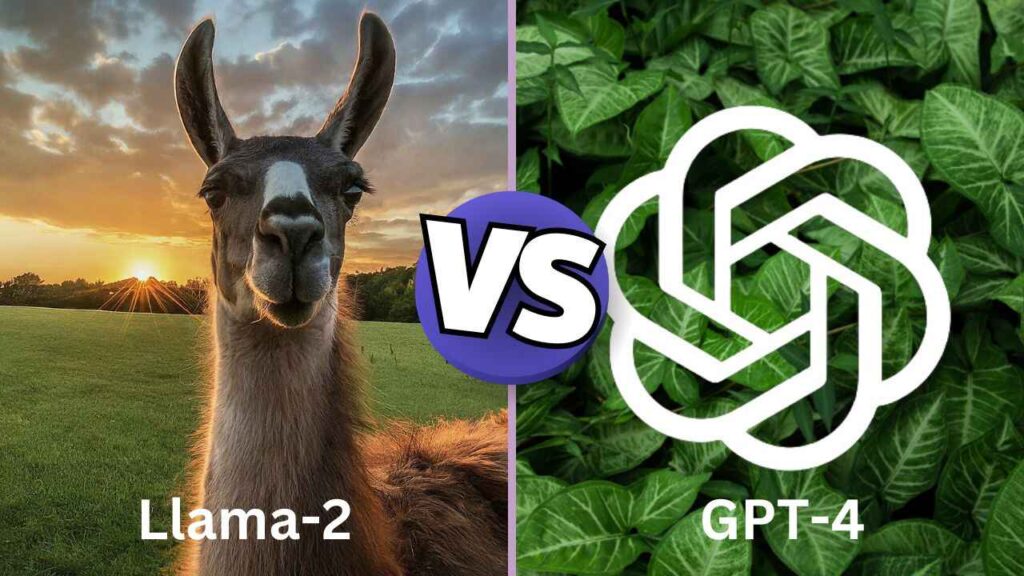
The world of large language models (LLMs) is heating up. Two titans, Meta’s Llama 2 and OpenAI’s GPT-4, are vying for dominance in this rapidly evolving field. But which LLM reigns supreme? This blog post dives deep into the key differences between Llama-2 vs GPT-4, analyzing their training data, model size, language support, capabilities, strengths, weaknesses, and availability.
What is Llama-2 and GPT-4
Llama-2 and GPT-4 are both large language models (LLMs), which are essentially advanced computer programs trained on massive amounts of text data. These models can perform a variety of tasks related to language, including:
- Generating text: They can create different creative text formats, like poems, code, scripts, musical pieces, emails, letters, etc.
- Answering your questions in an informative way, even if they are open ended, challenging, or strange.
- Translating languages: They can translate between many different languages.
Llama-2 vs GPT-4: Key Differences based on 7 Parameters
Here’s a breakdown of the key points to consider in the Llama 2 vs GPT-4 showdown:
Llama-2 vs GPT-4 Training Data:
Llama 2 boasts a massive dataset of 2 trillion tokens, while GPT-4 utilizes a robust 175 billion tokens. While GPT-4 isn’t far behind, Llama 2’s potentially wider exposure to text and code could lead to more comprehensive outputs.
Llama-2 vs GPT-4 Model Size:
Both models boast 175 billion parameters, indicating similar processing power and complexity. This close match suggests a tight race in terms of raw computational muscle.
Llama-2 vs GPT-4 Language Support:
Here, GPT-4 takes the lead with support for 26 languages compared to Llama 2’s 20. This broader language capability makes GPT-4 more versatile for multilingual tasks.
Llama-2 vs GPT-4 Capabilities:
Both models excel at generating text, translating languages, and crafting creative content. However, GPT-4 boasts additional functionalities like question answering, PDF comprehension, and even coding.
Llama-2 vs GPT-4 Strengths:
Llama 2 shines in terms of efficiency, user-friendliness, and safety. Its design prioritizes cost-effectiveness and minimizes the generation of offensive content.
Llama-2 vs GPT-4 Weaknesses:
While powerful, Llama 2’s training data size and language support lag behind GPT-4. Additionally, some experts suggest it might struggle with highly complex tasks compared to its competitor.
Llama-2 vs GPT-4 Availability:
Transparency is a key differentiator. Llama 2 embraces open-source accessibility through the Meta AI Platform. On the other hand, GPT-4 remains commercially available through OpenAI’s API, requiring a paid subscription.
Llama-2 vs GPT-4 for Coding
Choosing the right large language model (LLM) for your coding projects can be tricky. Here’s a simplified breakdown of Llama-2 and GPT-4 to help you pick your champion:
Focus: Coding Ability
- Winner: GPT-4. It outperforms Llama-2 in benchmark tests like HumanEval, demonstrating superior performance in tasks requiring strong logic and mathematical reasoning.
Strengths to Consider:
Llama-2:
- Efficiency: Runs faster and requires less computational power compared to GPT-4.
- Accessibility: Open-source and available through Meta AI Platform, making it a cost-effective option.
GPT-4:
- Complex Tasks: Handles intricate coding problems with high accuracy.
Cost and Availability:
- Llama-2: Free and readily available.
- GPT-4: Requires access to a paid API.
Choosing the Right Tool:
Pick GPT-4 if:
- You prioritize high-complexity coding tasks.
- Budget and paid access aren’t major concerns.
Pick Llama-2 if:
- You need a cost-effective solution for basic coding tasks.
- Efficiency and ease of use are most important.
Llama-2 vs GPT-4 Speed
When it comes to processing speed, Llama 2 takes the crown in the race between these two large language models (LLMs). Here’s a breakdown:
Speed Advantage:
- Llama-2: This LLM boasts superior efficiency, leading to faster inference times and less resource utilization. This translates to quicker response generation.
Reason for Speed:
- Architecture: Llama 2 utilizes innovative techniques like grouped-query attention, striking a balance between accuracy and speed during processing.
- Size: While both models have similar parameter sizes (175 billion), Llama 2’s design allows it to operate with less computational power.
GPT-4 Considerations:
- Powerhouse: While not the speed champion, GPT-4 remains a powerful LLM capable of handling complex tasks.
- Trade-off: Its larger size and complexity might require more resources, potentially impacting speed compared to Llama-2.
Choosing Based on Speed:
- Pick Llama-2 if: Real-time performance and fast response generation are crucial for your needs.
People Also Read- Llama 3 vs GPT 4 /Llama-2 vs GPT-4 vs Claude-2
Choosing Your LLM Champion: Llama-2 vs GPT-4
The ideal LLM depends on your specific needs. Here’s a quick guide:
-
Choose Llama 2 if: You prioritize affordability, user-friendliness, and safety in tasks like text generation and basic translation.
-
Choose GPT-4 if: You require a versatile model for complex tasks like coding, question answering, and multilingual content creation. Budget and access to a paid API wouldn’t be major hurdles.
The Future of LLMs: Beyond Llama-2 vs GPT-4
The LLM landscape is constantly evolving. Both Llama 2 and GPT-4 are likely to undergo continuous improvement. Additionally, other players are emerging in this exciting field. Staying updated on these advancements is crucial for making informed decisions when choosing the right LLM for your projects.
Conclusion
Llama-2 and GPT-4 both have unique strengths. Llama-2 is open-source, flexible, and community-driven, ideal for those who value customization and collaboration. GPT-4 offers superior power and reliability, perfect for high-stakes applications like coding.
Your choice depends on your needs. If you prioritize flexibility, Llama-2 is a great fit. If you need high performance and precision, go with GPT-4. The future of large language models could combine the best of both worlds.
People Ask Questions
How does llama2 compare to ChatGPT?
Is Llama better than GPT-3?
Yes, Llama is generally considered better than GPT-3 for several reasons:
- Accuracy: Llama shows better performance in tasks requiring factual accuracy and reasoning.
- Efficiency: Llama runs faster and is more cost-effective.
- Accessibility: Llama is open source, allowing for customization and transparency.
Is llama 2 cheaper than GPT?
Yes, Llama 2 is much cheaper than GPT, especially GPT-4. It offers similar accuracy for tasks like summarization at a significantly lower cost.